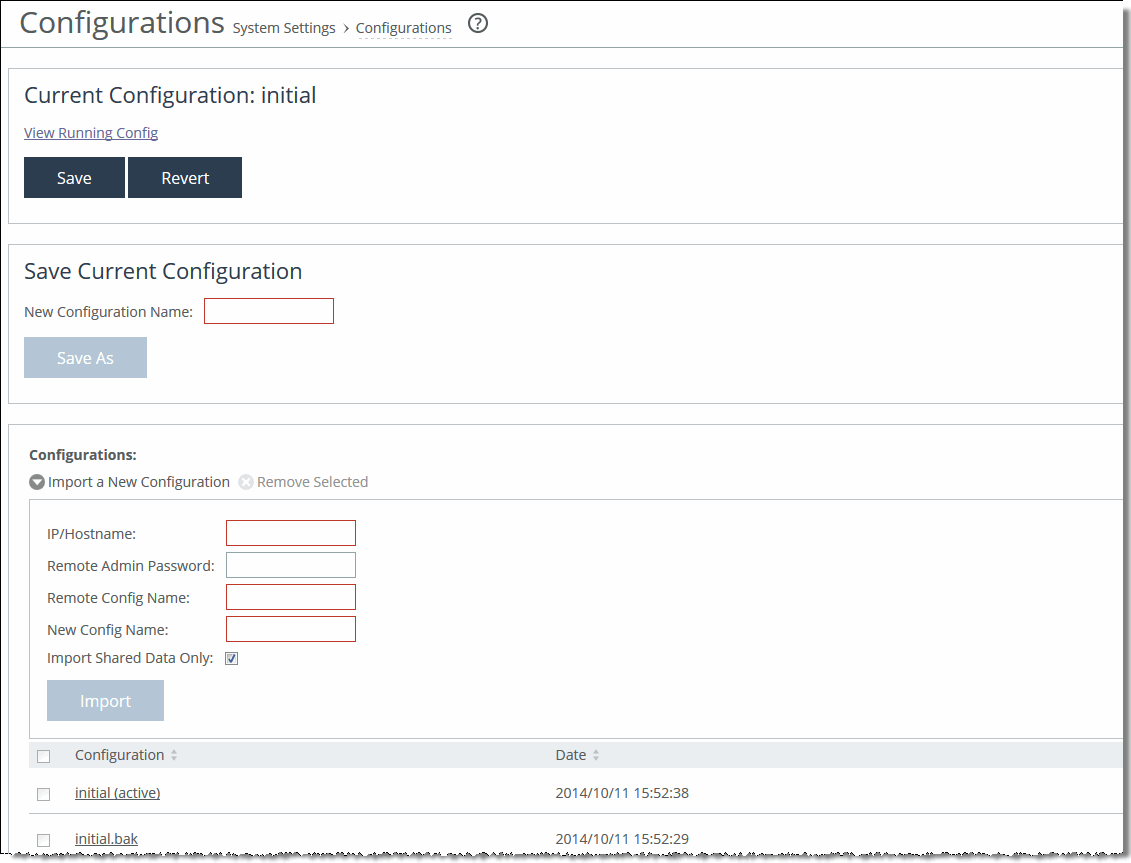Managing configuration files
You can save, activate, import, and revert configurations in the Administration > System Settings: Configurations page.
Each SteelHead has an active, running configuration and a written, saved configuration.
When you Apply your settings in the Management Console, the values are applied to the active running configuration, but the values aren’t written to disk and saved permanently.
When you Save your configuration settings, the values are written to disk and saved permanently. They take effect after you restart the optimization service.
Each time you save your configuration settings, they’re written to the current running configuration, and a backup is created. For example, if the running configuration is myconfig and you save it, myconfig is backed up to myconfig.bak and myconfig is overwritten with the current configuration settings.
The Configuration Manager is a utility that saves configurations as backups or active configuration backups.
The Configuration Manager also includes an Import Configuration utility to support these common use cases:
• Replacing a SteelHead appliance—If you are replacing one SteelHead for another, you can import all of the network information (although not the licenses) and disconnect the old SteelHead before you switch configurations on the new SteelHead.
• Configuration template for a large deployment—You can avoid entering the complete SteelHead configuration for every appliance in a large deployment by setting up a template SteelHead and importing template settings to the configuration list.
To manage configurations
1. Choose Administration > System Settings: Configurations to display the Configurations page.
Configurations page

2. Under Current Configuration: <filename>, complete the configuration as described in this table.
Control | Description |
Current Configuration: <configuration name> | View Running Config—Displays the running configuration settings in a new browser window. |
| Save—Saves settings that have been applied to the running configuration. |
| Revert—Reverts your settings to the running configuration. |
Save Current Configuration | Specify a new filename to save settings that have been applied to the running configuration as a new file, and then click Save. |
3. To import a configuration from another appliance, complete the configuration as described in this table.
Control | Description |
Import a New Configuration | Displays the controls to import a configuration from another appliance. |
IP/Hostname | Specify the IP address or hostname of the SteelHead from which you want to import the configuration. |
Remote Admin Password | Specify the administrator password for the remote SteelHead. |
Remote Config Name | Specify the name of the configuration you want to import from the remote SteelHead. |
New Config Name | Specify a new, local configuration name. |
Import Shared Data Only | Takes a subset of the configuration settings from the imported configuration and combines them with the current configuration to create a new configuration. Import shared data is enabled by default. |
Add | When the Import Shared Data Only check box is selected, activates the imported configuration and makes it the current configuration. This is the default. When the Import Shared Data Only check box is not selected, adds the imported configuration to the Configuration list. It doesn’t become the active configuration until you select it from the list and click Activate. |
Remove Selected | Select the check box next to the name and click Remove Selected. |
Change Active Configuration | Select the configuration to activate from the drop-down list. |
4. Click Activate.
Select the configuration name to display the configuration settings in a new browser window.


